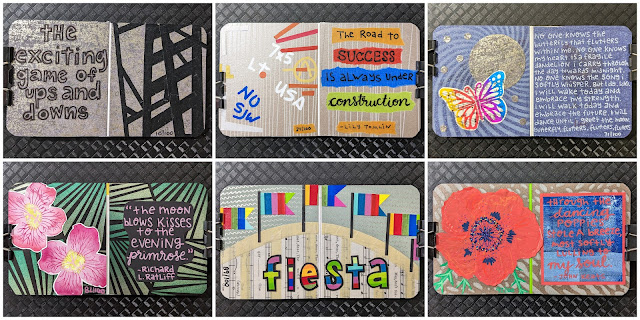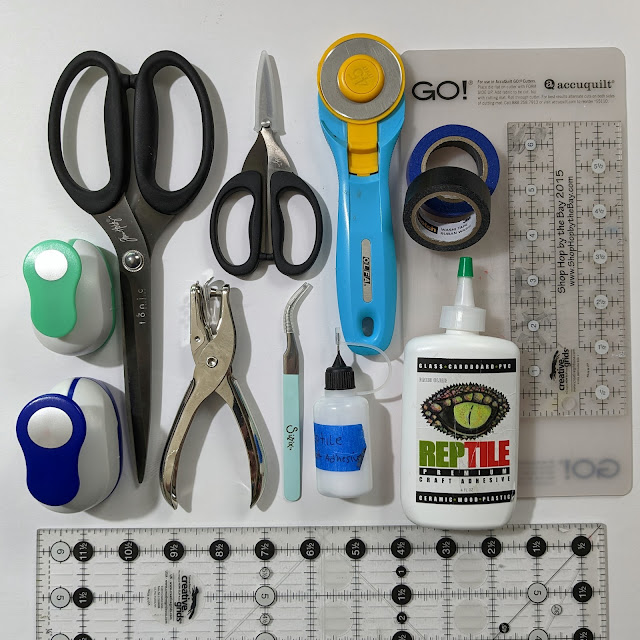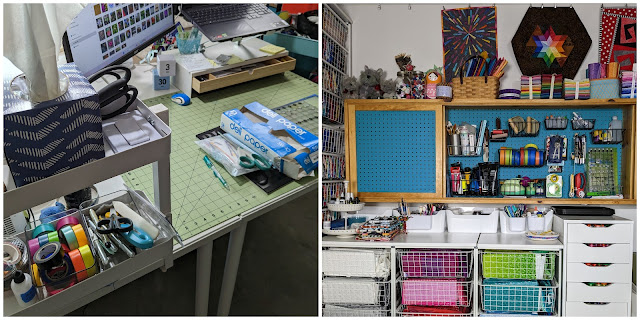100 Days of I Spy Dice Designs: Celebratory Wrap Up & Reflections on Fodder, Tools, Techniques, Organization/Storage, and Travel
Collaging Into Children's Board Books
Using children's board books for my I Spy Dice Design books was inspired by Drew Steinbrecher's free online, class: Build your Creativity: Board Book Basics. Used board books are readily available at thrift stores in a variety of sizes and shapes. For this series, I used this "My First Library" set as there were 10 books, each with 11 page spreads, plus they were very small and portable. I will confess that this smaller size definitely challenged me, especially at the start when I had originally planned to include the inspiration photo, text, and artwork all within each day's spread. By Day 3, I scrapped that plan and included a mosaic of all the inspiration photos in the first two pages of each book. This freed me up to use the full 7" x 4" spread to focus on text and art as inspired by the photo.
Rolling the Dice to Determine Fodder Used
Over the course of the 100 days, I rolled two dice. One die determined design inspiration, while the other determined what kind of fodder I would incorporate into my layered collage. Other fodder sources were also permitted, but this provided an opportunity to experiment with different kinds of fodder bits! Fodder is pretty much any kind of paper/medium that can be used in an art collage. Below are the different dice rolls, how many times I rolled them, examples of the fodder used, as well as daily spreads showcasing that particular fodder source!1. Junk Mail/Flyers-16 rolls
I took greater interest in my junk mail throughout these 100 days, especially the patterned linings of security envelopes. Now I find myself silently judging companies and organizations on their envelopes and feel disappointed by boring, plain envelopes! Here are just a few of the pages featuring patterned security envelopes.
6. Artist Choice-22 rolls
I always enjoy including an Artist Choice roll as it affords me the opportunity to explore my favorite sources of fodder and/or experiment with new materials that may not fit the assigned categories. Here are a few different sources of fodder that made repeat appearances in my daily collages:
Tape including washi tape and painter's tape to construct a ladder shadow, striped flags, lettering, and accents...
Mixed Media Techniques
Over the course of the 100 days, there were several techniques that were revisited in new and exciting ways as inspired by the dice rolls.
Block Printing: I couldn't resist the urge to incorporate block printing. Some days I revisited previously carved blocks and/or commercial foam stamps. Other days I was inspired to carve a new block and/or create a foam sticker stamp as inspired by the design photo.
Watercolor: For years, watercolor painting never really appealed to me partially because I perceived them to be difficult to control and they yielded very muted colors. Several of the Love Your Imperfect Hand Lettering challenges involved watercolor painting and so I decided to revisit watercolor painting. Wow--I was surprised by how much I enjoyed the meditative nature of watercolor painting! I purchased a Niji Artist Watercolors Essential Set of 12 Colors and watched several YouTube videos including Willa Wander's video demo on The Mother Method of Color Mixing for All Artists and All Paint Mediums. After seeing the range of colors that can be created from a limited color palette, I was hooked on watercolor painting! I especially enjoyed painting little bits that I could then carefully cut out and incorporate into my collages!
Tools:
- Tim Holtz Tonic brand Snips and Shears: I had the 5" Mini Snips (great for fussy cutting small elements) and the 9.5" Shears, but purchased the 7" towards the end of my project too.
- Circle Punches in a variety of sizes. Given the small size of my compositions, I used the 1", 3/4" and 1/4" the most, but I have several other larger sizes for use with larger projects.
- Sizzix Curved Fine Tip Tweezers: These are amazing for handling delicate elements especially when applying glue and placing within my compositions.
- Reptile Premium Craft Adhesive: Wendy Solganic aka Willa Wanders introduced me to this glue during one of her Fodder School lessons and I too love it because it sets fairly quickly and dries clear. I transferred it into a small bottle with a fine tip which worked even better for applying onto small bits.
- Assorted Washi Tape--both for taping down layers when tracing and block printing, as well as for designing.
- Rotary Cutter, Mat and Rulers: I had several from making quilts. My rotary cutter blade definitely needs to be changed after it was used with paper and often got bits of glue onto it when trimming each page even with the board book background. When traveling, I packed a small Accuquilt GO! cutting mat for use with my rotary cutter!
- Posca paint pens (large bullet tip and fine bullet tip)
- Uniball Signo UM 153 pens--they come in a variety of colors and I especially love the white, silver, and gold pens for use on dark backgrounds!
- Uniball Air pens that Wendy aka Willa Wanders introduced in her Love Your Imperfect Lettering course.
- Sakura's Gelly Roll pens
- Yasatomo's Niji Artist Watercolors Essential Set of 12 Colors and their Fusion Brushes sizes 2-5.
- Sakura's Micron Pens (available in a variety of colors and tips)
- Liqeo Pro Permanent Marker
Organization:
It's always interesting to see how my studio adapts for each 100 Day Project in order to have the materials and supplies readily accessible and organized. Earlier in the year, I purchased a small VATTENKAR Desktop shelf from IKEA which was perfect for holding many of my to-go tools: scissors, glue, rotary cutter, Washi tape, tweezers, etc next to where I did much of my creating. Behind me, my pegboard cabinet originally contained mostly quilting notions--many of which I rarely, if ever used. So I pulled everything out and consolidated much of the quilting gear to the right side, leaving the left side available for paints, circle cutters, and other mixed media tools!
Creating Throughout My Travels
- Top Row L to R: Asilomar Conference Center in Pacific Grove while teaching at Empty Spools Seminars (first two photos), Fresno hotel, and Toronto Hilton.
- Bottom Row: Southwest flight (first two) and Kauai trip (last two)
I feel like I am forgetting something big, but hopefully this captures the scope of my project and helps answer some of your questions. If you have other questions, leave a comment below.
Many thanks to everyone who joined me on this creative journey. Special thanks to all the artists who influenced my daily creations, all my family and friends who patiently waited as I paused to take lots of photos for inspiration, my travel companions who were understanding when I snuck away to create, and to all of you for your encouragement throughout this project!
































This was a fantastic article! I love the details you provided on your dice roll topics to use! The journals look so fun!!
ReplyDeleteAww...thank you! I am so glad you enjoyed this blog post and how the dice inspired me to play in these journals!
Delete